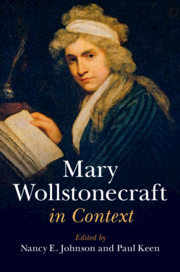Book contents
- Mary Wollstonecraft in Context
- Mary Wollstonecraft in Context
- Copyright page
- Contents
- Illustrations
- Notes on Contributors
- Preface
- Frontispiece
- Chronology
- Part I Life and Works
- Part II Critical Fortunes
- Part III Historical and Cultural Contexts
- The French Revolution Debate
- Chapter 9 Writing the French Revolution
- Chapter 10 Radical Societies
- Chapter 11 Radical Publishers
- Chapter 12 British Conservatism
- The Rights of Woman Debate
- Philosophical Frameworks
- Legal and Social Culture
- Literature
- Suggested Further Reading
- Index
Chapter 10 - Radical Societies
from The French Revolution Debate
Published online by Cambridge University Press: 16 January 2020
- Mary Wollstonecraft in Context
- Mary Wollstonecraft in Context
- Copyright page
- Contents
- Illustrations
- Notes on Contributors
- Preface
- Frontispiece
- Chronology
- Part I Life and Works
- Part II Critical Fortunes
- Part III Historical and Cultural Contexts
- The French Revolution Debate
- Chapter 9 Writing the French Revolution
- Chapter 10 Radical Societies
- Chapter 11 Radical Publishers
- Chapter 12 British Conservatism
- The Rights of Woman Debate
- Philosophical Frameworks
- Legal and Social Culture
- Literature
- Suggested Further Reading
- Index
Summary
When Mary Wollstonecraft became a professional writer in 1786 with the publication of Thoughts on the Education of Daughters, London debating societies were routinely discussing issues related to female manners such as “Can that Wife be truly said to love a Husband, who frequently disobeys him?” (yes, but only carried by a small majority) and “Whether it was not false Delicacy which forbid the fair sex making the first advances to the man they love?” (a great majority were against the lady doing so).1 While such societies had previously had a distinct atmosphere of alehouse masculinity, women had been admitted to public debating societies since the late 1770s and began to contribute to debates in 1780, as Mary Thale and Donna T. Andrews have observed.2 As one might imagine, debate topics with a feminine slant often related to questions around marital decorum and female manners, but were not absolutely limited to these issues. Debates on whether women should have a say in general elections, the compatibility of female nature with politics, and the nature of female education also took place. Women were not only allowed to attend and to participate in most debating societies in the early 1780s, they also established female-only societies such as La Belle Assemblée and the Female Parliament. Progress appeared to be considerable since the failure of Charles Macklin’s experiment in the 1750s when he tried to commercialize female participation in his short-lived British Inquisition venture.3 However, the years 1780–81 were the apex of female involvement in these debate forums as public taste declined for such events (perhaps because of the anxieties about social stability provoked by the Gordon riots) and by the end of the decade attitudes toward displays of female rhetorical agency remained decidedly ambivalent: The Times of October 29, 1788 opined that “the debating ladies would be better employed at their needle and thread, a good sempstress being a more amiable character than a female orator.”4 There was considerable resistance to female participation in rational-critical debate, but issues of interest to women were now nonetheless firmly part of public discourse and, as Thale has observed, these debating societies helped create the environment in which Mary Wollstonecraft and her ideas could be taken seriously.5
- Type
- Chapter
- Information
- Mary Wollstonecraft in Context , pp. 87 - 94Publisher: Cambridge University PressPrint publication year: 2020



